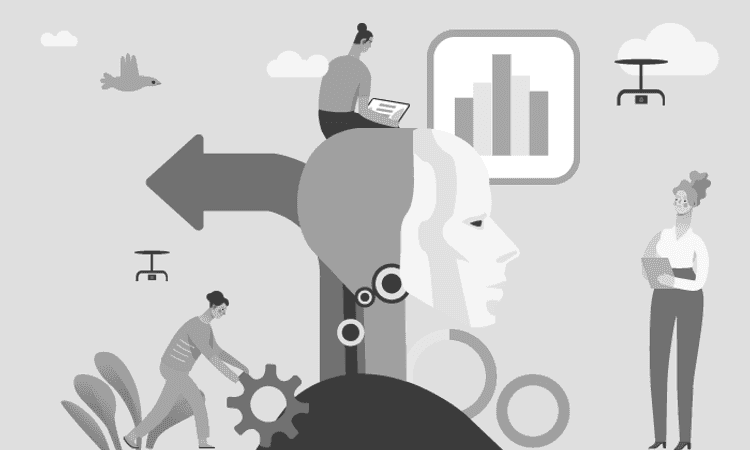How artificial intelligence innovations impact digital inclusion
The rapid evolution of artificial intelligence (AI) in recent years has led to major advances in various fields. It has also recently generated endless debate, with the emergence of ChatGPT, MidJourney, Firefly... These innovations have already begun to transform the way we interact with technology, and will shape a new chapter in our digital usage. However, this transformation is not necessarily beneficial for everyone.
As well as raising legitimate questions in terms of data protection, copyright and environmental footprint, AI is also a potential obstacle to digital inclusion. And yet, artificial intelligences are proving to be effective in terms of accessibility. So how can we ensure that these innovations are put to good use? To answer this question, we first need to understand what the impacts of AI are, both positive and negative.
The digital divide: a reality for 15% of the French population
Today, digital technology is a vital necessity: it is needed to access government sites, public services and educational resources, but it is also essential for social inclusion. However, around 15% of the French population is digitally excluded, and 17% is digitally illiterate. This is due first and foremost to a territorial dimension, with almost half of unconnected individuals living in rural areas. For some people on low incomes, the cost of equipment, Internet subscriptions and communications can also be excessive. What's more, there is a striking generational disparity, with over 50% of people over 75 not having Internet access from home, while only 2% of young people aged 15-29 are not equipped.
Heads : facilitated processes and adapted pathways
On the one hand, advances in artificial intelligence (AI) open up promising prospects for strengthening digital inclusion. Adaptive learning algorithms have the potential to be powerful tools for identifying and understanding the needs of marginalized populations, enabling the development of personalized solutions tailored to their specific needs. Voice interaction also represents a relevant solution for overcoming the obstacles associated with reading and writing on digital terminals for people with disabilities.
Furthermore, by simplifying and accelerating complex processes, AI enables greater accessibility to digital technologies. The automation of administrative procedures, for example, can make it easier for people in remote rural areas and/or who are illiterate to go online.

Tails : algorithm bias and influence
However, the use of AI can also exacerbate existing digital inequalities. Algorithms have a significant impact on the digital environment in which individuals evolve, notably by influencing their online behavior. This is particularly evident in content recommendations and targeted advertising. In this context, only users with a sufficient level of alertness and control can preserve their free will and fully understand their digital environment.
Another emerging issue is that of AI-generated discrimination. Unintentionally, an algorithm based on biased human data can make discriminatory decisions based on gender, financial situation or ethnic origin. The use of AIs by a company in recruitment processes, or by public authorities in criminal profiling, could therefore prove dramatic.
"Well-developed and tested algorithms can bring many improvements. However, without proper controls, developers and users run a high risk of having a negative impact on people's lives." Michael O'Flaherty, Director of the European Union Agency for Fundamental Rights (FRA)
The urgent need for clear regulation to avoid AI's drift in terms of digital inclusion
It's crucial to approach artificial intelligence in all its complexity, taking into account both the opportunities and the risks it creates. To focus solely on the benefits of this technology is to overlook the possible adverse consequences for our societies. As with any major technological advance, the widespread use of AI could accentuate disparities between individuals and exacerbate pre-existing digital exclusion among disadvantaged groups.
The ability of governments to draw up a strategy that fosters both technological development and adequate digital education for their populations on these issues is therefore decisive. It is also essential to put in place strict regulations to set the ethical, social and legal limits of this technology. The project is already underway in several countries, notably in the European Union with theAArtificial Intelligence Act. For MEPs, the challenge is to regulate on the right scale:
"The question of how to properly define AI has been very controversial throughout the AI Act process. Again, if you define AI too narrowly, you risk not being able to regulate certain harms. If you define it too broadly, you risk being too inclusive and stifling innovation." Johann Laux, AI regulation expert at the Oxford Internet Institute
The RGPD is already here in France to require companies to implement security measures to ensure the integrity of personal data stored in their information systems.
Companies must therefore be vigilant from now on when exploiting AI within their digital services: they cannot reasonably be seen as a miracle solution to be used without precautions. Rather, they should be seen as a tool with great potential that needs to be properly understood and mastered in order to be used in the most enlightened way possible. Only then can they be used for the benefit, and not at the expense, of digital inclusion and accessibility.
